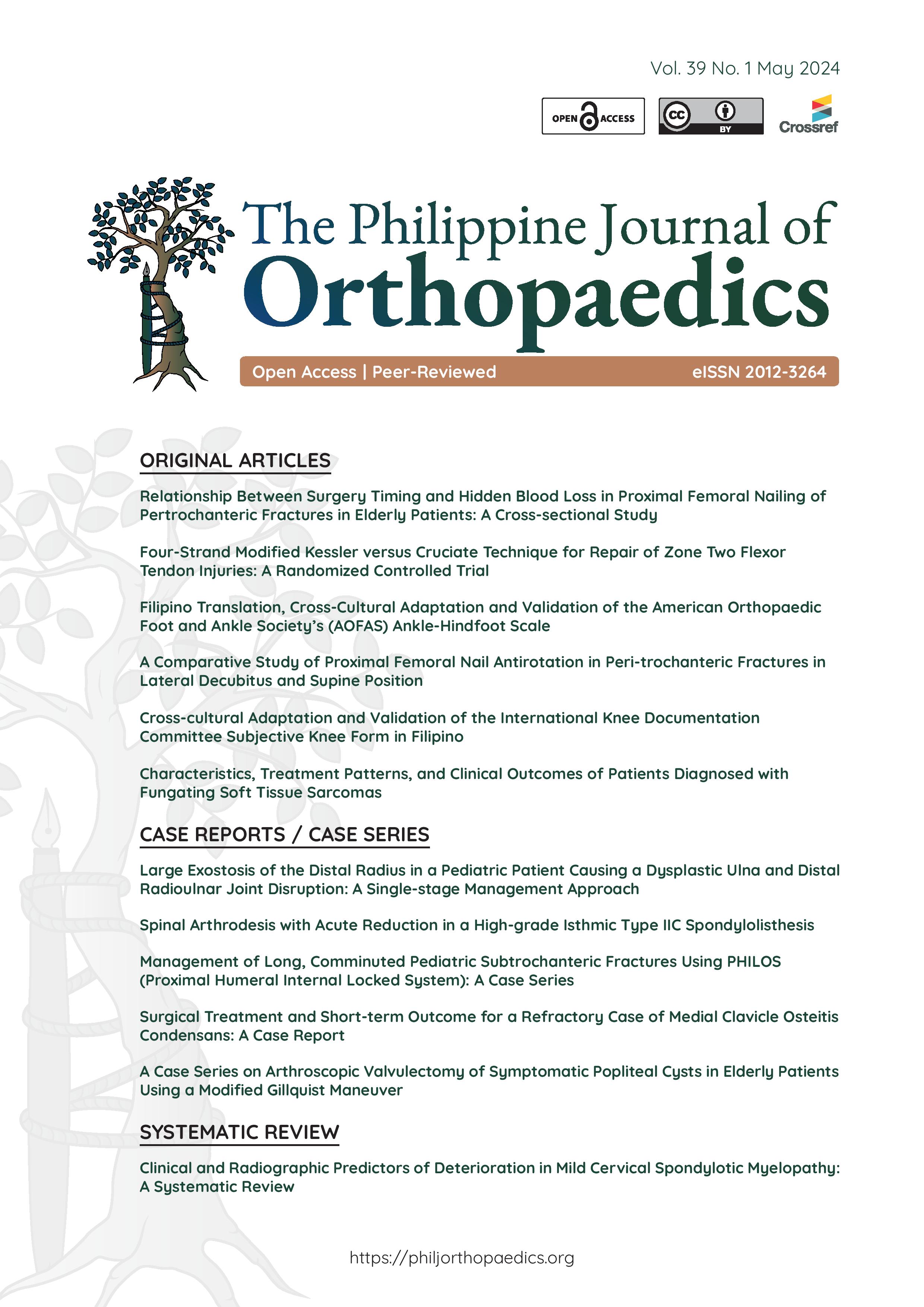Filipino Translation, Cross-Cultural Adaptation and Validation of the American Orthopedic Foot and Ankle Society’s (AOFAS) Ankle-Hindfoot Scale
Main Article Content
Abstract
Background. Injuries about the foot and ankle account for a significant number of injuries that may lead to substantial functional impairment and disability. A standardized method of outcome assessment is necessary to evaluate and monitor patients’ progress. One commonly used evaluation system is the American Orthopedic Foot and Ankle Society (AOFAS) Ankle and hindfoot scale. The purpose of this study was to translate the AOFAS Ankle-Hindfoot scale into Filipino and establish its cultural adaptation and validity.
Methodology. This was a single-center cross-sectional study that included patients with ankle and hindfoot conditions who took part in the evaluation of the proposed Filipino translation of the Ankle-Hindfoot Scale, following the guidelines set by the AOFAS. Construct validity and test-retest reliability were analyzed using intra-class correlation coefficients; internal consistency was analyzed with Cronbach’s alpha. A Rasch principal components analysis was also used to test for reliability and construct validity.
Results. Cronbach’s alpha was measured at 0.98 in terms of function, while the item separation index showed good internal consistency of the construct. Rasch analysis confirmed that the construct is a multidimensional metric. Intra-class correlation using Pearson’s coefficient was significant at 0.8779 (p <0.05), showing good test-retest reliability, while convergent validity confirmed a strong positive correlation between the overall AOFAS score and the health perception domain of the Medical Outcomes Study Questionnaire Short Form-36 (SF-36 v2) (Tagalog) (Pearson = 0.647).
Conclusions. The Filipino translation of the AOFAS Ankle-Hindfoot Scale was successfully translated and culturally adapted to Filipino patients, with good internal consistency. We have likewise demonstrated a good correlation against a general health outcome measure (SF-36 v2) in terms of change in health perception and role limitation (physical).
Article Details

This work is licensed under a Creative Commons Attribution 4.0 International License.

This work is licensed under a Creative Commons Attribution 4.0 International License.
References
Shultz S, Olszewski A, Ramsey O, Schmitz M, Wyatt V, Cook C. A systematic review of outcome tools used to measure lower leg conditions. Int J Sports Phys Ther. 2013;8(6):838-48. https://pubmed.ncbi.nlm.nih.gov/24377070. https://www.ncbi.nlm.nih.gov/pmc/articlesPMC3867077.
Kitaoka HB, Alexander IJ, Adelaar RS, Nunley JA, Myerson MS, Sanders M. Clinical rating systems for the ankle-hindfoot, midfoot, hallux, and lesser toes. Foot Ankle Int. 1994;15(7):349‐53. https://pubmed.ncbi.nlm.nih.gov/7951968. https://doi.org/10.1177/107110079401500701.
Alhadhoud M, Alsiri N, Alsaffar M, Glazebrook M. Cross-cultural adaptation and validation of an Arabic version of the American Orthopedics Foot and Ankle Score (AOFAS). Foot Ankle Surg. 2020;26(8):876-82. https://pubmed.ncbi.nlm.nih.gov/31870616. https://doi.org/10.1016/j.fas.2019.11.001.
Beaton DE, Bombardier C, Guillemin F, Ferraz MB. Guidelines for the process of cross-cultural adaptation of self-report measures. Spine (Phila Pa 1976). 2000;25(24):3186-91. https://pubmed.ncbi.nlm.nih.gov/11124735. https://doi.org/10.1097/00007632-200012150-00014.
Benson J, Clark F. A guide for instrument development and validation. Am J Occup Ther. 1982;36(12):789-800. https://pubmed.ncbi.nlm.nih.gov/6927442. https://doi.org/10.5014/ajot.36.12.789.
Pallant JF, Tennant A. An introduction to the Rasch measurement model: an example using the Hospital Anxiety and Depression Scale (HADS). Br J Clin Psychol. 2007;46(Pt 1):1-18. https://pubmed.ncbi.nlm.nih.gov/17472198. https://doi.org/10.1348/014466506x96931
Koo TK, Li MY. A guideline of selecting and reporting intraclass correlation coefficients for reliability research. J Chiropr Med. 2016;15(2):155-63. https://pubmed.ncbi.nlm.nih.gov/27330520. https://www.ncbi.nlm.nih.gov/pmc/articlesPMC4913118. https://doi.org/10.1016/j.jcm.2016.02.012.
Castillo-Carandang NT, Sison OT, Grefal M et al. A community-based validation study of the Short-Form 36 version 2 Philippines (Tagalog) in two cities in the Philippines. PLoS ONE. 2013;8(12):e83794. https://pubmed.ncbi.nlm.nih.gov/24386281. https://www.ncbi.nlm.nih.gov/pmc/articlesPMC3873385. https://doi.org/10.1371/journal.pone.0083794.
Boone WJ, Noltemeyer A, Yates G (Reviewing editor). Rasch analysis: a primer for school psychology researchers and practitioners. Cogent Education. 2017;4(1):1416898. https://doi.org/10.1080/2331186X.2017.1416898.
Linacre JM. A user guide to Winsteps Ministep Rasch model computer programs: program manual 3.75.0. Accessed November 10, 2020. http://www.winsteps.com/a/winsteps-manual.pdf.
Rodrigues RC, Masiero D, Mizusaki JM, et al Translation, cultural adaptation, and validity of the “American Orthopaedic Foot and Ankle Society (AOFAS) Ankle-Hindfoot Scale." Acta Ortopédica Brasileira. 2008;16(2):107-11. https://doi.org/10.1590/S1413-78522008000200009.
SooHoo NF, Shuler M, Fleming LL. Evaluation of the validity of the AOFAS clinical rating systems by correlation to the SF-36. Foot Ankle Int. 2003;24(1):50-5. https://pubmed.ncbi.nlm.nih.gov/12540082. https://doi.org/10.1177/107110070302400108.





